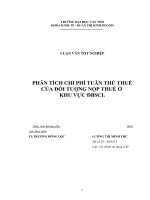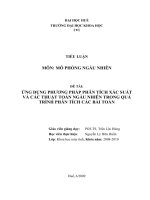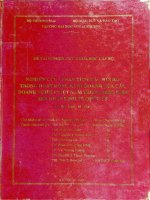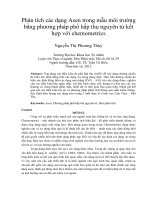Phân tích các bài đọc trong toeic 7 docx
Bạn đang xem bản rút gọn của tài liệu. Xem và tải ngay bản đầy đủ của tài liệu tại đây (63.59 KB, 6 trang )
(A) Roads
(B) Barns
(C) Monuments
(D) Water systems
9. The pueblos are considered one of the Anasazis' supreme achievements
for all of the following reasons EXCEPT that they were
(A) very large
(B) located in forests
(C) built with simple tools
(D) connected in a systematic way
Questions 10-20
Accustomed though we are to speaking of the films made before 1927 as "silent,"
the film has never been, in the full sense of the word, silent. From the very beginning,
music was regarded as an indispensable accompaniment ; when the Lumiere films were
Line shown at the first public film exhibition in the Unites States in February 1896, they
(5) were accompanied by piano improvisations on popular tunes. At first, the music played
bore no special relationship to the films ; an accompaniment of any kind was sufficient.
Within a very short time, however, the incongruity of playing lively music to a solemn
film became apparent, and film pianists began to take some care in matching their
pieces to the mood of the film.
(10) As movie theaters grew in number and importance, a violinist, and perhaps a cellist,
would be added to the pianist in certain cases, and in the larger movie theaters small
orchestras were formed. For a number of years the selection of music for each film
program rested entirely in the hands of the conductor or leader of the orchestra, and
very often the principal qualification for holding such a position was not skill or taste
(15) so much as the ownership of a large personal library of musical pieces. Since the
conductor seldom saw the films until the night before they were to be shown (if,
indeed, the conductor was lucky enough to see them then), the musical arrangement
was normally improvised in the greatest hurry.
To help meet this difficulty, film distributing companies started the practice of
(20) publishing suggestions for musical accompaniments. In 1909, for example, the Edison
Company began issuing with their films such indications of mood as "pleasant," "sad,"
"lively." The suggestions became more explicit, and so emerged the musical cue sheet
containing indications of mood, the titles of suitable pieces of music, and precise
directions to show where one piece led into the next.
(25) Certain films had music especially composed for them. The most famous of these
early special scores was that composed and arranged for D.W. Griffith's film Birth of
a Nation, which was released in 1915.
10. The passage mainly discusses music that was
(A) performed before the showing of a film
(B) played during silent films
(C) specifically composed for certain movie theaters
(D) recorded during film exhibitions
11. What can be inferred from the passage about the majority of films
made after 1927 ?
(A) They were truly "silent."
(B) They were accompanied by symphonic orchestras.
(C) They incorporated the sound of the actors' voices.
(D) They corresponded to specific musical compositions.
12. The word "solemn" in line 7 is closest in meaning to
(A) simple
(B) serious
(C) short
(D) silent
13. It can be inferred that orchestra conductors who worked in movie
theaters needed to
(A) be able to play many instruments
(B) have pleasant voices
(C) be familiar with a wide variety of music
(D) be able to compose original music
14. The word "them" in line 17 refers to
(A) years
(B) hands
(C) pieces
(D) films
15. According to the passage, what kind of business was the Edison Company?
(A) It produced electricity.
(B) It distributed films.
(C) It published musical arrangements.
(D) It made musical instruments.
16. It may be inferred from the passage that the first musical cue sheets
appeared around
(A) 1896
(B) 1909
(C) 1915
(D) 1927
17. Which of the following notations is most likely to have been included on
a musical cue sheet of the early 1900's?
(A) "Calm, peaceful"
(B) "Piano, violin"
(C) "Key of C major"
(D) "Directed by D.W. Griffith"
18. The word " composed" in line 26 is closest in meaning to
(A) selected
(B) combined
(C) played
(D) created
19. The word "scores" in line 26 is closest in meaning to
(A) totals
(B) successes
(C) musical compositions
(D) groups of musicians
20. The passage probably continues with a discussion of
(A) famous composers of the early twentieth century
(B) other films directed by D.W. Griffith
(C) silent films by other directors
(D) the music in Birth of a Nation
Questions 21-30
The Earth comprises three principal layers : the dense, iron-rich core, the mantle
made of silicate rocks that are semimolten at depth, and the thin, solid-surface crust.
There are two kinds of crust, a lower and denser oceanic crust and an upper, lighter
Line continental crust found over only about 40 percent of the Earth's surface. The rocks
(5) of the crust are of very different ages. Some continental rocks are over 3,000 million
years old, while those of the ocean floor are less then 200 million years old. The crusts
and the top, solid part of the mantle, totaling about 70 to 100 kilometers in thickness,
at present appear to consist of about 15 rigid plates, 7 of which are very large. These
plates move over the semimolten lower mantle to produce all of the major topographical
(10) features of the Earth. Active zones where intense deformation occurs are confined to
the narrow, interconnecting boundaries of contact of the plates.
There are three main types of zones of contact : spreading contacts where plates
move
apart, converting contacts where plates move towards each other, and transform
contacts where plates slide past each other. New oceanic crust is formed along one or
(15) more margins of each plate by material issuing from deeper layers of the Earth's crust,
for example, by volcanic eruptions of lava at midocean ridges. If at such a spreading
contact the two plates support continents, a rift is formed that will gradually widen and
become flooded by the sea. The Atlantic Ocean formed like this as the American and
Afro-European plates moved in opposite directions. At the same time at margins of
(20) converging plates, the oceanic crust is being reabsorbed by being subducted into the
mantle and remelted beneath the ocean trenches. When two plates carrying continents
collide, the continental blocks, too light to be drawn down, continue to float and
therefore buckle to form a mountain chain along the length of the margin of the plates.
21. The word "comprises" in line 1 is closest in meaning to
(A) adapts to
(B) benefits from
(C) consists of
(D) focuses on
22. According to the passage, on approximately what percent of the
Earth's surface is the continental crust found?
(A) 15
(B) 40
(C) 70
(D) 100
23. The word "which" in line 8 refers to
(A) crusts
(B) kilometers
(C) plates
(D) continents
24. The word "intense" in line 10 is closest in meaning to
(A) surface
(B) sudden
(C) rare
(D) extreme
25. What does the second paragraph of the passage mainly discuss?
(A) The major mountain chains of the Earth
(B) Processes that create the Earth's surface features
(C) The composition of the ocean floors
(D) The rates at which continents move
26. Which of the following drawings best represents a transform contact (line 13-14)?
27. The word "margins" in line 15 is closest in meaning to
(A) edges
(B) peaks
(C) interiors
(D) distances
28. The word "support" in line 17 is closest in meaning to
(A) separate
(B) create
(C) reduce
(D) hold
29. According to the passage, mountain ranges are formed then
(A) the crust is remelted
(B) two plates separate
(C) a rift is flooded
(D) continental plate collide
30. Where in the passage does the author describe how oceans are formed?
(A) Lines 3-4
(B) Lines 6-8
(C) Lines 16-18
(D) Lines 19-21
Questions 31-39
Coincident with concerns about the accelerating loss of species and habitats has
been a growing appreciation of the importance of biological diversity, the number of
species in a particular ecosystem, to the health of the Earth and human well-being.
Line Much has been written about the diversity of terrestrial organisms, particularly the
(5) exceptionally rich life associated with tropical rain-forest habitats. Relatively little has
been said, however, about diversity of life in the sea even though coral reef systems are
comparable to rain forests in terms of richness of life.
An alien exploring Earth would probably give priority to the planet's dominant,
most-distinctive feature ― the ocean. Humans have a bias toward land that sometimes
(10) gets in the way of truly examining global issues. Seen from far away, it is easy to
realize that landmasses occupy only one-third of the Earth's surface. Given that two-
thirds of the Earth's surface is water and that marine life lives at all levels of the ocean,
the total three-dimensional living space of the ocean is perhaps 100 times greater than
that of land and contains more than 90 percent of all life on Earth even though the
(15) ocean has fewer distinct species.
The fact that half of the known species are thought to inhabit the world's rain forests
does not seem surprising, considering the huge numbers of insects that comprise the
bulk of the species. One scientist found many different species of ants in just one tree
from a rain forest. While every species is different from every other species, their
(20) genetic makeup constrains them to be insects and to share similar characteristics with
750,000 species of insects. If basic, broad categories such as phyla and classes are
given more emphasis than differentiating between species, then the greatest diversity of
life is unquestionably the sea. Nearly every major type of plant and animal has some
representation there.
(25) To appreciate fully the diversity and abundance of life in the sea, it helps to think
small. Every spoonful of ocean water contains life, on the order of 100 to 100,000
bacterial cells plus assorted microscopic plants and animals, including larvae of
organisms ranging from sponges and corals to starfish and clams and much more.
31. What is the main point of the passage?
(A) Humans are destroying thousands of species.
(B) There are thousands of insect species.
(C) The sea is even richer in life than the rain forests.
(D) Coral reefs are similar to rain forests.
32. The word "appreciation" in line 2 is closest in meaning to
(A) ignorance
(B) recognition
(C) tolerance
(D) forgiveness
33. Why does the author compare rain forests and coral reefs(lines 4-7) ?
(A) They are approximately the same size.
(B) They share many similar species.
(C) Most of their inhabitants require water.
(D) Both have many different forms of life.
34. The word "bias" in line 9 is closest in meaning to
(A) concern
(B) disadvantage
(C) attitude
(D) prejudice
35. The passage suggests that most rain forest species are
(A) insects
(B) bacteria
(C) mammals
(D) birds
36. The word "there" in line 24 refers to
(A) the sea
(B) the rain forests
(C) a tree
(D) the Earth's surface









